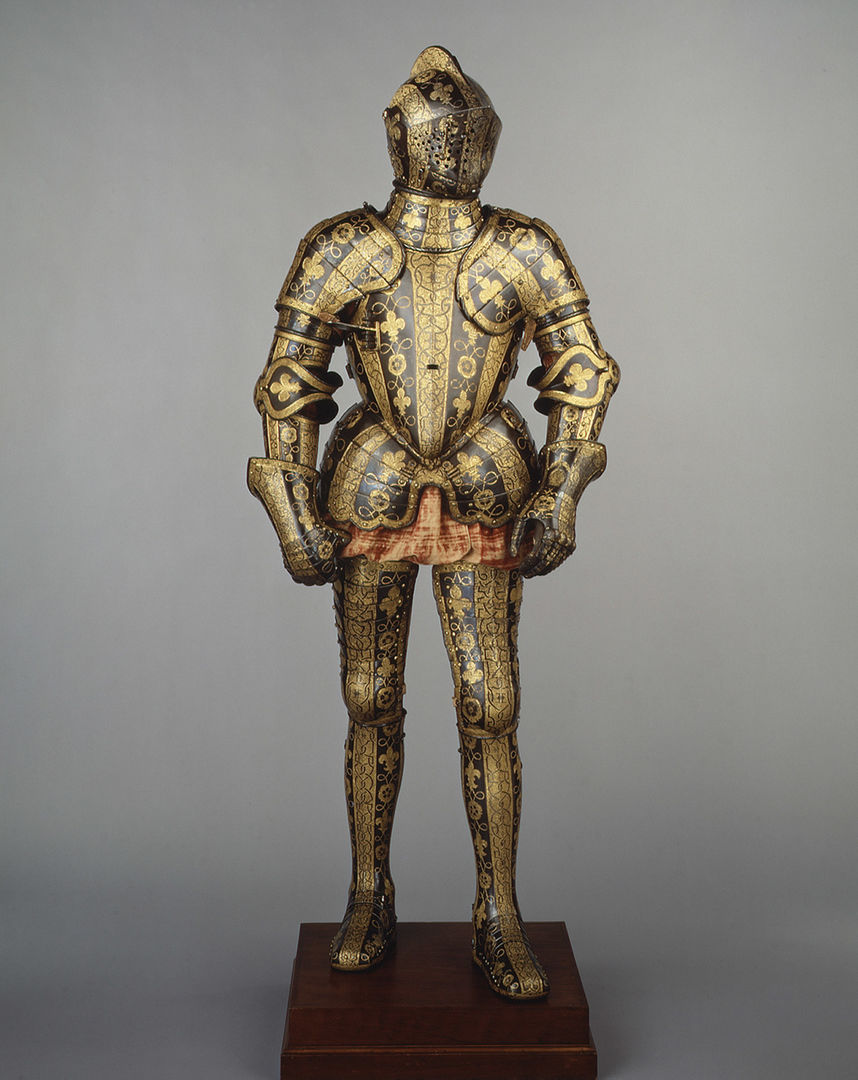Armor—Function and Design

Armor of George Clifford, Third Earl of Cumberland, about 1580–85, made in the Royal Workshops. English (Greenwich). Steel, etched, blued, and gilded, H. 69 1/2 in. (176.5 cm), Wt. 60 lb. (27.2 kg). The Metropolitan Museum of Art, New York, Munsey Fund, 1932 (32.130.6)
Collection Areas: Arms and Armor, European Art
Subject Areas: English Language Arts, Science, Visual Arts, World History
Grades: Elementary School
Topics/Themes: Power and Leadership, Animals in Art
Goals
Students will be able to:
- identify moveable and static features on a suit of armor;
- recognize the functional and symbolic significance of surface detail; and
- note similarities and differences between Sir George Clifford's armor and animal "armor."
National Learning Standards
English Language Arts
NL-ENG.K-12.2 Reading for Understanding
NL-ENG.K-12.6 Applying Knowledge
NL-ENG.K-12.12 Applying Language Skills
Science
NS.K-12.3 Life Science
Visual Arts
NA-VA.K-12.2 Using Knowledge of Structures and Functions
NA-VA.K-12.4 Understanding the Visual Arts in Relation to History and Cultures
NA-VA.K-12.6 Making Connections between Visual Arts and Other Disciplines
World History
NSS-WH.5-12.6 Era 6: The Emergence of the First Global Age, 1450–1770
Common Core State Standards
English Language Arts
CCSS.ELA-Literacy.CCRA.SL.2 Integrate and evaluate information presented in diverse media and formats, including visually, quantitatively, and orally.
CCSS.ELA-Literacy.CCRA.SL.4 Present information, findings, and supporting evidence such that listeners can follow the line of reasoning and the organization, development, and style are appropriate to task, purpose, and audience.
CCSS.ELA-Literacy.CCRA.W.10 Write routinely over extended time frames (time for research, reflection, and revision) and shorter time frames (a single sitting or a day or two) for a range of tasks, purposes, and audiences.
Questions for Viewing
- This suit is comprised of fourteen different pieces; take a moment to note where each piece ends and another begins.
- Imagine putting the suit on. What would you put on first (or last)? Why?
- Which parts of this suit support movement? How? Describe the range of motion each area might support.
- Which areas offer the most protection? What do you see that makes you say that?
- This suit of armor, created for the English knight Sir George Clifford, covered his face and body. What clues might people use to identify him?
- The rose (a symbol of the royal Tudor family), the fleur-de-lis (a symbol of England's claim to several French territories), and back-to-back letter Es featured on this suit of armor honor the family of Queen Elizabeth I. Where do you see examples of these shapes on this suit and helmet? How are they organized?
- This suit of armor was designed to offer protection from weapons such as swords and lances. How is the form of this suit similar to or different from the clothing worn today to protect people from bad weather?
Activity
Activity Setting: Museum and Classroom
Materials: Paper, pencils, and nonfiction books about animals
Subject Areas: Science, Visual Arts
Duration: 30 minutes
Explore ways animals such as armadillos, turtles, and porcupines use "armor" to protect themselves. Create a labeled sketch of each animal noting qualities such as hard, soft, smooth, and sharp in the margins. Discuss how each animal uses these attributes for protection and what similarities, if any, you see between these natural features and Sir George Clifford’s suit of armor.
Resources
Breiding, Dirk H. "Arms and Armor in Renaissance Europe." In Heilbrunn Timeline of Art History. New York: The Metropolitan Museum of Art, 2000–. (October 2002)
Breiding, Dirk H. and Edward A. Hunter, with Masha Turchinsky, under the curatorial direction of Stuart W. Pyhrr. "Beyond Battle." New York: The Metropolitan Museum of Art, 2013–. Download the free iTunes app (iPad only).
"Made in the Royal Workshops: Armor of George Clifford, Third Earl of Cumberland [English (Greenwich)] (32.130.6)." In Heilbrunn Timeline of Art History. New York: The Metropolitan Museum of Art, 2000–. (October 2006)
Pyhrr, Stuart W., et al. The Armored Horse in Europe, 1480–1620. New York: The Metropolitan Museum of Art, 2005.
Raditsa, Bosiljka, Rebecca Arkenberg, Rika Burnham, Deborah Krohn, Kent Lydecker, and Teresa Russo. The Art of Renaissance Europe: A Resource for Educators. New York: The Metropolitan Museum of Art, 2000. Download the resource (PDF).
Objects in the Museum's Collection Related to this Lesson
Armor, about 1400–1450. Italian. Steel, brass, textile; H. 66 1/2 in. (168.9 cm). The Metropolitan Museum of Art, New York, Bashford Dean Memorial Collection Gift of Helen Fahnestock Hubbard, in memory of her father, Harris C. Fahnestock, 1929 (29.154.3)
Armor (Gusoku), 16th and 18th centuries. Japanese. Lacquered iron, mail, silk, copper-gilt, H. 67 1/2 in. (171.5 cm). The Metropolitan Museum of Art, New York, Gift of Bashford Dean, 1914 (14.100.172)
Author: Adapted from The Art of Renaissance Europe: A Resource for Educators, The Metropolitan Museum of Art, 2010